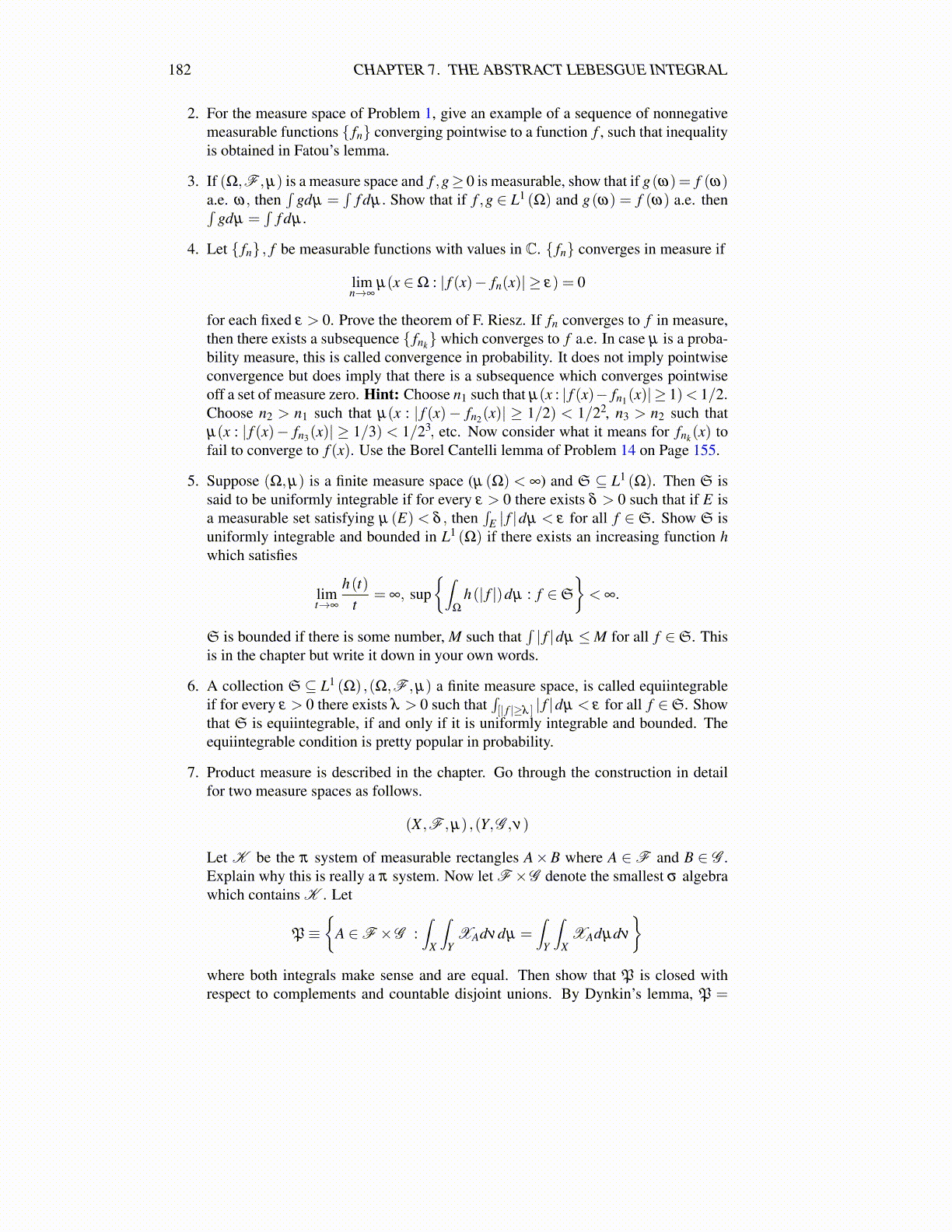
182 CHAPTER 7. THE ABSTRACT LEBESGUE INTEGRAL
2. For the measure space of Problem 1, give an example of a sequence of nonnegativemeasurable functions { fn} converging pointwise to a function f , such that inequalityis obtained in Fatou’s lemma.
3. If (Ω,F ,µ) is a measure space and f ,g≥ 0 is measurable, show that if g(ω)= f (ω)a.e. ω, then
∫gdµ =
∫f dµ. Show that if f ,g ∈ L1 (Ω) and g(ω) = f (ω) a.e. then∫
gdµ =∫
f dµ .
4. Let { fn} , f be measurable functions with values in C. { fn} converges in measure if
limn→∞
µ(x ∈Ω : | f (x)− fn(x)| ≥ ε) = 0
for each fixed ε > 0. Prove the theorem of F. Riesz. If fn converges to f in measure,then there exists a subsequence { fnk} which converges to f a.e. In case µ is a proba-bility measure, this is called convergence in probability. It does not imply pointwiseconvergence but does imply that there is a subsequence which converges pointwiseoff a set of measure zero. Hint: Choose n1 such that µ(x : | f (x)− fn1(x)| ≥ 1)< 1/2.Choose n2 > n1 such that µ(x : | f (x)− fn2(x)| ≥ 1/2) < 1/22, n3 > n2 such thatµ(x : | f (x)− fn3(x)| ≥ 1/3) < 1/23, etc. Now consider what it means for fnk(x) tofail to converge to f (x). Use the Borel Cantelli lemma of Problem 14 on Page 155.
5. Suppose (Ω,µ) is a finite measure space (µ (Ω) < ∞) and S ⊆ L1 (Ω). Then S issaid to be uniformly integrable if for every ε > 0 there exists δ > 0 such that if E isa measurable set satisfying µ (E) < δ , then
∫E | f |dµ < ε for all f ∈S. Show S is
uniformly integrable and bounded in L1 (Ω) if there exists an increasing function hwhich satisfies
limt→∞
h(t)t
= ∞, sup{∫
Ω
h(| f |)dµ : f ∈S
}< ∞.
S is bounded if there is some number, M such that∫| f |dµ ≤M for all f ∈S. This
is in the chapter but write it down in your own words.
6. A collection S ⊆ L1 (Ω) ,(Ω,F ,µ) a finite measure space, is called equiintegrableif for every ε > 0 there exists λ > 0 such that
∫[| f |≥λ ] | f |dµ < ε for all f ∈S. Show
that S is equiintegrable, if and only if it is uniformly integrable and bounded. Theequiintegrable condition is pretty popular in probability.
7. Product measure is described in the chapter. Go through the construction in detailfor two measure spaces as follows.
(X ,F ,µ) ,(Y,G ,ν)
Let K be the π system of measurable rectangles A×B where A ∈F and B ∈ G .Explain why this is really a π system. Now let F ×G denote the smallest σ algebrawhich contains K . Let
P≡{
A ∈F ×G :∫
X
∫Y
XAdνdµ =∫
Y
∫X
XAdµdν
}where both integrals make sense and are equal. Then show that P is closed withrespect to complements and countable disjoint unions. By Dynkin’s lemma, P =